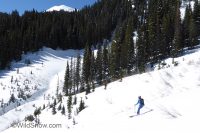Editor’s note: This series of basic tips is something we’ve had published for a while. Lots of newcomers to the sport these days, so we figured surfacing and editing it would be good. No sense letting this kind of content just linger in the past and clutter up the web. Please commenters, add your own tips.
1. When we take newcomers out backcountry ski touring this time of year, what to wear is question number one. If you’re hiking for your turns, you will roast unless you use a good layering system.
Consider simple softshell pants for your legs. Look for pants made of fairly thin breathable fabric with thigh vents (many such pants are intended more as a mid-winter garment, and may be too warm for spring). For layering if the weather turns, carry a pair of lighter weight hard-shell pants in your pack, (but don’t wear slick hard-shell nylon for steep skiing — see below).
Your torso is tougher to dress for uphill sweating. While cotton clothing is usually verboten in the backcountry, in spring weather a cotton t-shirt or button-down may be the only layer that’ll keep you cool and still protect your skin from the sun, pack abrasions and such.
If the weather turns nasty, be sure to strip your damp cotton before adding layers. Attempting to use ANY cotton clothing for warmth can be dangerous, since it extracts heat from your body if damp or wet (and backcountry clothing usually ends up damp).
An alternative to cotton is any acrylic or nylon type fabric. Shirts made from such tend to pass moisture better than cotton does, and will dry in moments if you hang them from your skis or a tree during a break — but they don’t keep you as cool and comfortable as good ‘ol cotton.
2. Beware the “slide for life.” Every spring we hear numerous stories of backcountry skiers taking terrifying and sometimes fatal sliding falls down steep mountain snow. I’ve witnessed a few such falls. It’s amazing how fast you accelerate, then begin “rag dolling” with no chance of stopping. Many of these falls could be minimized or entirely prevented by clothing choice. While backcountry skiing on snow steeper than about 30 degrees, wear soft shell fabrics or wool garments, rather then slick nylon. Consider packing your crampons or rope on the outside of your pack, in such a way as to drag against the snow if you fall. And consider using a ski pole self-arrest grip such as the Black Diamond Whippet if you generally ski without falling, and do tackle steep terrain.
Equally important in preventing death falls: know your limits. If you can do “no-fall” skiing you’re qualified for steep terrain. If you fall occasionally, proceed with caution and dial back your expectations.
Tip 1&2
Tip 3
Tip 4
Tip 5
Tip 6
Tip 7
Tip 8
Tip 9
Tip 10
WildSnow.com publisher emeritus and founder Lou (Louis Dawson) has a 50+ years career in climbing, backcountry skiing and ski mountaineering. He was the first person in history to ski down all 54 Colorado 14,000-foot peaks, has authored numerous books about about backcountry skiing, and has skied from the summit of Denali in Alaska, North America’s highest mountain.

